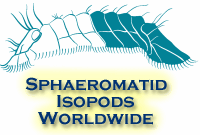| Abstract |
We examined embryos of representatives of crustaceans, myriapods and insects with respect to DII expression in the mouthparts. In order to examine the relationships between mandibular DII expression and the occurrence of a mandibular palp we compared amphipod, isopod and decapod crustacean species. In species with mandibular palps, DII expression is maintained throughout development and is restricted to the palps. The species lacking a palp as an adult show only transient DII expression in early embryonic stages. Furthermore, we studied mandibular DII expression in the myriapod Glomeris marginata that lacks like all myriapods mandibular palps as an adult. The expression pattern is similar to that in crustaceans lacking a palp as an adult. We examined entognathous and ectognathous insects. No sign of mandibular expression could be detected. It is shown that the distal parts of the mandibular appendage were reduced in several steps and lineages independently up to a total loss. Furthermore, we studied DII expression in the first and second maxillae. Except for Glomeris and the collembolans, the first maxillae of all species show a similar pattern of three lobes expressing DII: the outer expression marks the maxillary palp and the inner two mark the outgrowing endites (galea and lacinia of insects). In the first maxillae of collembolans only two expression areas could be detected. In palpless adult first maxillae of isopod crustaceans a transitory embryonic palp occurs which is also DII positive. In the second maxillae of insects, isopod and amphipod crustaceans only two DII-positive lobes occur. Our data suggest a gnathobasic character of the mandibles of crustaceans, myriapods and insects supporting the monophyly of Mandibulata sensu Snodgrass. The interpretation of DII expression patterns and its limits are critically evaluated. |

















